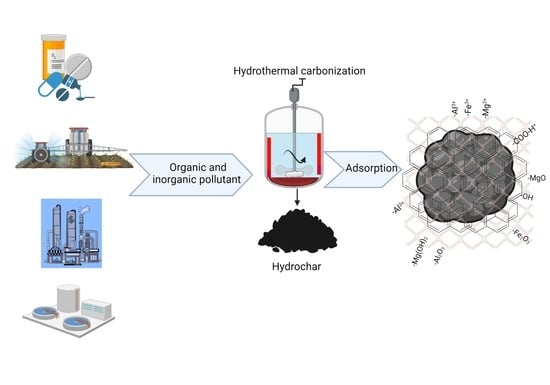Harnessing Activated Hydrochars: A Novel Approach for Pharmaceutical Contaminant Removal
Abstract
1. Introduction
2. Methodology
3. The Emergence of Hydrochar as a Sustainable Adsorbent
3.1. Production Methods for Hydrochars
3.1.1. Feedstock Selection
3.1.2. Hydrothermal Reactor Utilization
3.1.3. Cooling and Depressurization
3.1.4. Collection and Post-Treatment
3.1.5. Versatility and Tailoring
3.2. Activation Techniques for Enhancing Adsorption Properties
4. Sustainable Aspects of Hydrochar Production
5. Characterization of Activated Hydrochars
6. Adsorption Mechanisms of Hydrochars
6.1. Surface Chemistry and Functional Groups
6.2. Interaction between Pharmaceutical Contaminants and Hydrochars
6.3. Adsorption Modeling: Isotherms, Kinetics, and Thermodynamic Analysis
6.3.1. Kinetics Models
6.3.2. Equilibrium Models
6.3.3. Thermodynamic Analysis
6.4. Applications of Activated Hydrochars in Pharmaceutical Contaminant Removal
6.5. Removal Efficiency and Factors Influencing Adsorption
6.6. Regulations and Guidelines for Pharmaceutical Contaminants
7. Advantages and Limitations
8. Sustainability and Economic Viability
8.1. Environmental Benefits of Activated Hydrochar
8.2. Cost-Effectiveness and Scalability
8.3. Scalability
8.4. Life Cycle Analysis
9. Challenges and Future Directions
9.1. Challenges
9.2. Future Directions
- Diversified Feedstock Utilization: The exploration and incorporation of an expanded spectrum of feedstock materials, including unconventional sources such as algae, waste plastics, and byproducts originating from various industries, to enrich the diversity and properties of hydrochars.
- Enhanced Pre-processing Techniques: The development of effective pre-processing methodologies aimed at mitigating feedstock variability and enhancing the uniformity of hydrochar properties.
- Advanced Production Methodologies: Research into advanced production techniques, encompassing approaches like microwave-assisted hydrothermal carbonization (MAHTC) and continuous-flow systems, designed to bolster the efficiency and scalability of hydrochar manufacturing.
- Tailored Hydrochars: Investigations into methods for customizing hydrochars to target specific pharmaceutical contaminants or other pollutants, potentially involving surface functional group modifications or the introduction of nanoparticles to enhance selectivity.
- Regeneration Technique Refinement: Improvement in regeneration techniques with the goal of extending the operational lifespan of hydrochars, thereby reducing the necessity for continuous production and diminishing waste generation.
- Scaling Challenges Addressed: Examination of engineering challenges related to the upscaling of hydrochar production from laboratory to industrial scales, covering aspects such as reactor design, energy efficiency, and cost-effectiveness.
- Integration with Conventional Treatment: Exploration of the integration of hydrochar-based treatment systems with conventional water treatment processes to optimize pharmaceutical contaminant removal.
- Real-time Monitoring and Control: Development of real-time monitoring and control systems capable of adapting treatment processes based on contaminant concentrations and feedstock properties to enhance operational efficiency.
- Resource Recovery Opportunities: Investigation of prospects for resource recovery from hydrochar production, such as the extraction of valuable compounds from feedstock or hydrochar materials.
- Cost–Benefit Analyses: Conducting comprehensive cost–benefit analyses to ascertain the economic feasibility of hydrochar-based treatment solutions compared to traditional methodologies, thereby substantiating the case for investment and adoption.
- Market Expansion: Expanding markets for hydrochar products, with a particular focus on its utility as a soil amendment, by educating agricultural stakeholders about the advantages of hydrochar in agriculture.
- Public Awareness and Acceptance: Elevating public awareness and acceptance through outreach programs and the provision of information regarding the safety and efficacy of hydrochar in water treatment and environmental applications.
- Interdisciplinary Collaboration: Fostering interdisciplinary collaboration among researchers, engineers, policymakers, and industry stakeholders to address intricate challenges and stimulate innovation.
- Comprehensive Environmental Impact Assessment: Continuation of comprehensive life cycle assessments (LCAs) and environmental impact studies to discern the complete environmental repercussions of hydrochar utilization.
- Pilot Studies and Demonstrations: Implementation of pilot studies and demonstration projects to validate the efficacy of hydrochar-based treatment solutions under real-world conditions.
- Waste Reduction Strategies: Exploration of methodologies to minimize waste generation during hydrochar production and consideration of waste utilization or valorization strategies.
- Advocacy for Regulatory Support: Advocacy for regulatory support and the establishment of standards that endorse the responsible utilization of hydrochars and acknowledge their potential benefits.
9.3. Future Research Prospects
- Exploration of Tailoring Techniques: Systematic investigations into methods for customizing the physicochemical properties of hydrochar, encompassing surface functional groups, porosity, and specific surface area, to augment its adsorption capacity and specificity for pharmaceutical contaminants.
- Nanomaterial Integration: Delving into the integration of nanoparticles and nanomaterials into hydrochar matrices to engineer nanostructured hydrochars with enhanced adsorption efficiency specifically tailored for targeted contaminants.
- Advanced Production Processes: Research into advanced hydrothermal and pyrolysis procedures aimed at producing hydrochars with optimized properties, potentially utilizing waste or biomass-derived feedstocks.
- Regeneration Techniques: Improvement and development of cost-effective hydrochar regeneration methodologies to extend its operational lifespan and curtail waste generation.
- Scaling Up Challenges: Addressing engineering and logistical challenges associated with upscaling hydrochar production for large-scale water treatment applications.
- Hybrid Treatment Systems: Exploration of the synergistic integration of hydrochar with other treatment technologies, including membrane filtration, activated carbon, or biological treatment, to forge hybrid systems that harness the strengths of each component for superior pharmaceutical contaminant removal.
- Adaptive Treatment Systems: Development of intelligent and adaptive treatment systems capable of dynamically adjusting hydrochar utilization based on real-time water quality monitoring and pharmaceutical contaminant concentrations.
- Contaminant Recovery Strategies: Investigation of techniques for desorbing and recovering pharmaceutical contaminants from loaded hydrochar materials, enabling their safe disposal or recycling.
- Environmental Fate and Impact Assessments: Conducting comprehensive environmental fate and impact studies to gauge the long-term repercussions of hydrochar application on soil, water, and ecosystems.
- Cost–Benefit Analyses: Undertaking cost–benefit analyses to discern the economic viability of hydrochar deployment in comparison to alternative treatment methods.
- Knowledge Dissemination: Promotion of the adoption of hydrochar-based solutions in water treatment, agriculture, and environmental remediation through concerted awareness campaigns and dissemination of knowledge.
- Regulatory Frameworks: Advocating for the establishment of regulatory frameworks and guidelines conducive to the responsible and widespread utilization of hydrochar in water and environmental applications.
- Interdisciplinary Collaboration: Encouraging interdisciplinary research collaborations involving experts in chemistry, engineering, environmental science, and public health to address multifaceted challenges at the interface of water quality and public health.
- Resource Mobilization: Securing resources and funding for research endeavors in the field and soliciting investment from both the public and private sectors to bolster the development of hydrochar technology.
10. Conclusions
Author Contributions
Funding
Acknowledgments
Conflicts of Interest
References
- Berihun, G.; Abebe, M.; Hassen, S.; Gizeyatu, A.; Berhanu, L.; Teshome, D.; Walle, Z.; Desye, B.; Sewunet, B.; Keleb, A. Drinking water contamination potential and associated factors among households with under-five children in rural areas of Dessie Zuria District, Northeast Ethiopia. Front. Public Health 2023, 11, 1199314. [Google Scholar] [CrossRef] [PubMed]
- Pandey, P.K.; Kass, P.H.; Soupir, M.L.; Biswas, S.; Singh, V.P. Contamination of water resources by pathogenic bacteria. AMB Express 2014, 4, 51. [Google Scholar] [CrossRef] [PubMed]
- Daughton, C.G.; Ternes, T.A. Pharmaceuticals and personal care products in the environment: Agents of subtle change? Environ. Health Perspect. 1999, 107 (Suppl. 6), 907–938. [Google Scholar] [CrossRef] [PubMed]
- Daughton, C.G. Pharmaceuticals and Personal Care Products in the Environment: Overarching Issues and Overview; ACS Publications: Washington, DC, USA, 2001. [Google Scholar]
- Bexfield, L.M.; Toccalino, P.L.; Belitz, K.; Foreman, W.T.; Furlong, E.T. Hormones and pharmaceuticals in groundwater used as a source of drinking water across the United States. Environ. Sci. Technol. 2019, 53, 2950–2960. [Google Scholar] [CrossRef] [PubMed]
- Nikolaou, A.; Meric, S.; Fatta, D. Occurrence patterns of pharmaceuticals in water and wastewater environments. Anal. Bioanal. Chem. 2007, 387, 1225–1234. [Google Scholar] [CrossRef]
- Zenker, A.; Cicero, M.R.; Prestinaci, F.; Bottoni, P.; Carere, M. Bioaccumulation and biomagnification potential of pharmaceuticals with a focus to the aquatic environment. J. Environ. Manag. 2014, 133, 378–387. [Google Scholar] [CrossRef]
- Mezzelani, M.; Gorbi, S.; Regoli, F. Pharmaceuticals in the aquatic environments: Evidence of emerged threat and future challenges for marine organisms. Mar. Environ. Res. 2018, 140, 41–60. [Google Scholar] [CrossRef]
- Mondal, S.; Xu, J.; Chen, G.; Huang, S.; Huang, C.; Yin, L.; Ouyang, G. Solid-phase microextraction of antibiotics from fish muscle by using MIL-101(Cr)NH2-polyacrylonitrile fiber and their identification by liquid chromatography-tandem mass spectrometry. Anal. Chim. Acta 2019, 1047, 62–70. [Google Scholar] [CrossRef]
- Mondal, S.; Jiang, J.; Li, Y.; Ouyang, G. Carbon and tin-based polyacrylonitrile hybrid architecture solid phase microextraction fiber for the detection and quantification of antibiotic compounds in aqueous environmental systems. Molecules 2019, 24, 1670. [Google Scholar] [CrossRef]
- Manyi-Loh, C.; Mamphweli, S.; Meyer, E.; Okoh, A. Antibiotic use in agriculture and its consequential resistance in environmental sources: Potential public health implications. Molecules 2018, 23, 795. [Google Scholar] [CrossRef]
- Kock, A.; Glanville, H.; Law, A.; Stanton, T.; Carter, L.; Taylor, J. Emerging challenges of the impacts of pharmaceuticals on aquatic ecosystems: A diatom perspective. Sci. Total Environ. 2023, 878, 162939. [Google Scholar] [CrossRef] [PubMed]
- Xin, X.; Huang, G.; Zhang, B. Review of aquatic toxicity of pharmaceuticals and personal care products to algae. J. Hazard. Mater. 2020, 410, 124619. [Google Scholar] [CrossRef] [PubMed]
- Gebreyes, W.A.; Dupouy-Camet, J.; Newport, M.; Oliveira, C.; Schlesinger, L.S.; Saif, Y.M.; Kariuki, S.; Saif, L.J.; Saville, W.; Wittum, T.; et al. The global one health paradigm: Challenges and opportunities for tackling infectious diseases at the human, animal, and environment interface in low-resource settings. PLoS Neglected Trop. Dis. 2014, 8, e3257. [Google Scholar] [CrossRef] [PubMed]
- Imwene, K.; Ngumba, E.; Kairigo, P. Emerging technologies for enhanced removal of residual antibiotics from source-separated urine and wastewaters: A review. J. Environ. Manag. 2022, 322, 116065. [Google Scholar] [CrossRef] [PubMed]
- Mondal, S.; Aikat, K.; Halder, G. Sorptive uptake of Ranitidine hydrochloride by Parthenium hysterophorus based chemically treated N-biochar in static bed continuous flow system. Results Surf. Interfaces 2022, 8, 100071. [Google Scholar] [CrossRef]
- Pandis, P.K.; Kalogirou, C.; Kanellou, E.; Vaitsis, C.; Savvidou, M.G.; Sourkouni, G.; Zorpas, A.A.; Argirusis, C. Key points of advanced oxidation processes (aops) for wastewater, organic pollutants and pharmaceutical waste treatment: A mini review. Chemengineering 2022, 6, 8. [Google Scholar] [CrossRef]
- Zhou, Y.; Leong, S.Y.; Li, Q. Modified biochar for removal of antibiotics and antibiotic resistance genes in the aqueous environment: A review. J. Water Process. Eng. 2023, 55, 104222. [Google Scholar] [CrossRef]
- Zhou, T.; Zhang, Z.; Liu, H.; Dong, S.; Nghiem, L.D.; Gao, L.; Chaves, A.V.; Zamyadi, A.; Li, X.; Wang, Q. A review on microalgae-mediated biotechnology for removing pharmaceutical contaminants in aqueous environments: Occurrence, fate, and removal mechanism. J. Hazard. Mater. 2023, 443, 130213. [Google Scholar] [CrossRef]
- Rivera-Utrilla, J.; Sánchez-Polo, M.; Ferro-García, M.Á.; Prados-Joya, G.; Ocampo-Perez, R. Pharmaceuticals as emerging contaminants and their removal from water. A review. Chemosphere 2013, 93, 1268–1287. [Google Scholar] [CrossRef]
- Ahmed, M.; Hameed, B. Removal of emerging pharmaceutical contaminants by adsorption in a fixed-bed column: A review. Ecotoxicol. Environ. Saf. 2018, 149, 257–266. [Google Scholar] [CrossRef]
- Wang, T.; Zhai, Y.; Zhu, Y.; Li, C.; Zeng, G. A review of the hydrothermal carbonization of biomass waste for hydrochar formation: Process conditions, fundamentals, and physicochemical properties. Renew. Sustain. Energy Rev. 2018, 90, 223–247. [Google Scholar] [CrossRef]
- Masoumi, S.; Borugadda, V.B.; Nanda, S.; Dalai, A.K. Hydrochar: A Review on Its Production Technologies and Applications. Catalysts 2021, 11, 939. [Google Scholar] [CrossRef]
- Ighalo, J.O.; Rangabhashiyam, S.; Dulta, K.; Umeh, C.T.; Iwuozor, K.O.; Aniagor, C.O.; Eshiemogie, S.O.; Iwuchukwu, F.U.; Igwegbe, C.A. Recent advances in hydrochar application for the adsorptive removal of wastewater pollutants. Chem. Eng. Res. Des. 2022, 184, 419–456. [Google Scholar] [CrossRef]
- Azzaz, A.A.; Khiari, B.; Jellali, S.; Ghimbeu, C.M.; Jeguirim, M. Hydrochars production, characterization and application for wastewater treatment: A review. Renew. Sustain. Energy Rev. 2020, 127, 109882. [Google Scholar] [CrossRef]
- Yaah, V.B.K.; Zbair, M.; de Oliveira, S.B.; Ojala, S. Hydrochar-derived adsorbent for the removal of diclofenac from aqueous solution. Nanotechnol. Environ. Eng. 2021, 6, 1–12. [Google Scholar] [CrossRef]
- Gascó, G.; Paz-Ferreiro, J.; Álvarez, M.; Saa, A.; Méndez, A. Biochars and hydrochars prepared by pyrolysis and hydrothermal carbonisation of pig manure. Waste Manag. 2018, 79, 395–403. [Google Scholar] [CrossRef]
- Shyam, S.; Arun, J.; Gopinath, K.P.; Ribhu, G.; Ashish, M.; Ajay, S. Biomass as source for hydrochar and biochar production to recover phosphates from wastewater: A review on challenges, commercialization, and future perspectives. Chemosphere 2022, 286, 131490. [Google Scholar] [CrossRef]
- Mestre, A.S.; Tyszko, E.; Andrade, M.A.; Galhetas, M.; Freire, C.; Carvalho, A.P. Sustainable activated carbons prepared from a sucrose-derived hydrochar: Remarkable adsorbents for pharmaceutical compounds. RSC Adv. 2015, 5, 19696–19707. [Google Scholar] [CrossRef]
- Sharma, H.B.; Sarmah, A.K.; Dubey, B. Hydrothermal carbonization of renewable waste biomass for solid biofuel production: A discussion on process mechanism, the influence of process parameters, environmental performance and fuel properties of hydrochar. Renew. Sustain. Energy Rev. 2020, 123, 109761. [Google Scholar] [CrossRef]
- Chen, H.; Xu, J.; Lin, H.; Zhao, X.; Shang, J.; Liu, Z. Arsenic removal via a novel hydrochar from livestock waste co-activated with thiourea and γ-Fe2O3 nanoparticles. J. Hazard. Mater. 2021, 419, 126457. [Google Scholar] [CrossRef]
- Ferrentino, R.; Ceccato, R.; Marchetti, V.; Andreottola, G.; Fiori, L. Sewage sludge hydrochar: An option for removal of methylene blue from wastewater. Appl. Sci. 2020, 10, 3445. [Google Scholar] [CrossRef]
- Zhang, Z.; Zhu, Z.; Shen, B.; Liu, L. Insights into biochar and hydrochar production and applications: A review. Energy 2019, 171, 581–598. [Google Scholar] [CrossRef]
- Sivaranjanee, R.; Kumar, P.S.; Rangasamy, G. A recent advancement on hydrothermal carbonization of biomass to produce hydrochar for pollution control. Carbon Lett. 2023, 33, 1909–1933. [Google Scholar] [CrossRef]
- Tag, A.T.; Duman, G.; Yanik, J. Influences of feedstock type and process variables on hydrochar properties. Bioresour. Technol. 2018, 250, 337–344. [Google Scholar] [CrossRef]
- Lima, E.C.; Naushad, M.; Reis, G.S.D.; Dotto, G.L.; Pavan, F.A.; Guleria, A.; Seliem, M.K.; Sher, F. Production of carbon-based adsorbents from lignocellulosic biomass. In Biomass-Derived Materials for Environmental Applications; Elsevier: Amsterdam, The Netherlands, 2022; pp. 169–192. [Google Scholar]
- Kambo, H.S.; Dutta, A. A comparative review of biochar and hydrochar in terms of production, physico-chemical properties and applications. Renew. Sustain. Energy Rev. 2015, 45, 359–378. [Google Scholar] [CrossRef]
- Sun, Y.; Gao, B.; Yao, Y.; Fang, J.; Zhang, M.; Zhou, Y.; Chen, H.; Yang, L. Effects of feedstock type, production method, and pyrolysis temperature on biochar and hydrochar properties. Chem. Eng. J. 2014, 240, 574–578. [Google Scholar] [CrossRef]
- Puccini, M.; Stefanelli, E.; Hiltz, M.; Seggiani, M.; Vitolo, S. Activated carbon from hydrochar produced by hydrothermal carbonization of wastes. Chem. Eng. Trans. 2017, 57, 169–174. [Google Scholar]
- Liu, L.; Cai, W.; Dang, C.; Han, B.; Chen, Y.; Yi, R.; Fan, J.; Zhou, J.; Wei, J. One-step vapor-phase assisted hydrothermal synthesis of functionalized carbons: Effects of surface groups on their physicochemical properties and adsorption performance for Cr(VI). Appl. Surf. Sci. 2020, 528, 146984. [Google Scholar] [CrossRef]
- Li, Y.; Tsend, N.; Li, T.; Liu, H.; Yang, R.; Gai, X.; Wang, H.; Shan, S. Microwave assisted hydrothermal preparation of rice straw hydrochars for adsorption of organics and heavy metals. Bioresour. Technol. 2019, 273, 136–143. [Google Scholar] [CrossRef]
- Congsomjit, D.; Areeprasert, C. Hydrochar-derived activated carbon from sugar cane bagasse employing hydrothermal carbonization and steam activation for syrup decolorization. Biomass Convers. Biorefinery 2021, 11, 2569–2584. [Google Scholar] [CrossRef]
- Tasca, A.L.; Clematis, D.; Marco, P.; Vitolo, S.; Puccini, M. Herbicide removal from water: Investigating the potential of electrochemistry and hydrochar-based activated carbon. Chem. Eng. Trans. 2019, 74, 841–846. [Google Scholar]
- Zhang, X.; Wang, Y.; Cai, J.; Wilson, K.; Lee, A.F. Bio/hydrochar sorbents for environmental remediation. Energy Environ. Mater. 2020, 3, 453–468. [Google Scholar] [CrossRef]
- Isemin, R.; Muratova, N.; Kuzmin, S.; Klimov, D.; Kokh-Tatarenko, V.; Mikhalev, A.; Milovanov, O.; Dalibard, A.; Ibitowa, O.A.; Nowotny, M.; et al. Characteristics of Hydrochar and Liquid Products Obtained by Hydrothermal Carbonization and Wet Torrefaction of Poultry Litter in Mixture with Wood Sawdust. Processes 2021, 9, 2082. [Google Scholar] [CrossRef]
- Islam, T.; Sultana, A.I.; Chambers, C.; Saha, S.; Saha, N.; Kirtania, K.; Reza, M.T. Recent Progress on Emerging Applications of Hydrochar. Energies 2022, 15, 9340. [Google Scholar] [CrossRef]
- Dehghani, M.H.; Ahmadi, S.; Ghosh, S.; Othmani, A.; Osagie, C.; Meskini, M.; AlKafaas, S.S.; Malloum, A.; Khanday, W.A.; Jacob, A.O.; et al. Recent advances on sustainable adsorbents for the remediation of noxious pollutants from water and wastewater: A critical review. Arab. J. Chem. 2023, 16, 105303. [Google Scholar] [CrossRef]
- Padhye, L.P.; Bandala, E.R.; Wijesiri, B.; Goonetilleke, A.; Bolan, N. Hydrochar: A promising step towards achieving a circular economy and sustainable development goals. Front. Chem. Eng. 2022, 4, 867228. [Google Scholar] [CrossRef]
- Hu, B.; Wang, K.; Wu, L.; Yu, S.; Antonietti, M.; Titirici, M. Engineering carbon materials from the hydrothermal carbonization process of biomass. Adv. Mater. 2010, 22, 813–828. [Google Scholar] [CrossRef] [PubMed]
- Khoshbouy, R.; Takahashi, F.; Yoshikawa, K. Preparation of high surface area sludge-based activated hydrochar via hydrothermal carbonization and application in the removal of basic dye. Environ. Res. 2019, 175, 457–467. [Google Scholar] [CrossRef]
- Zhao, Y.; Sun, Y.; Liu, S.; Wang, K.; Jiang, Y. Pore structure characterization of coal by NMR cryoporometry. Fuel 2017, 190, 359–369. [Google Scholar] [CrossRef]
- Achaw, O.-W. A study of the porosity of activated carbons using the scanning electron microscope. In Scanning Electron Microscopy; InTechOpen: London, UK, 2012. [Google Scholar] [CrossRef]
- Apaydın-Varol, E.; Pütün, A.E. Preparation and characterization of pyrolytic chars from different biomass samples. J. Anal. Appl. Pyrolysis 2012, 98, 29–36. [Google Scholar] [CrossRef]
- Mudunkotuwa, I.A.; Al Minshid, A.; Grassian, V.H. ATR-FTIR spectroscopy as a tool to probe surface adsorption on nanoparticles at the liquid–solid interface in environmentally and biologically relevant media. Analyst 2014, 139, 870–881. [Google Scholar] [CrossRef] [PubMed]
- Masoumi, S.; Dalai, A.K. Optimized production and characterization of highly porous activated carbon from algal-derived hydrochar. J. Clean. Prod. 2020, 263, 121427. [Google Scholar] [CrossRef]
- Cárdenas-Aguiar, E.; Gascó, G.; Paz-Ferreiro, J.; Méndez, A. Thermogravimetric analysis and carbon stability of chars produced from slow pyrolysis and hydrothermal carbonization of manure waste. J. Anal. Appl. Pyrolysis 2019, 140, 434–443. [Google Scholar] [CrossRef]
- Tran, T.H.; Le, A.H.; Pham, T.H.; Nguyen, D.T.; Chang, S.W.; Chung, W.J. Adsorption isotherms and kinetic modeling of methylene blue dye onto a carbonaceous hydrochar adsorbent derived from coffee husk waste. Sci. Total Environ. 2020, 725, 138325. [Google Scholar] [CrossRef] [PubMed]
- Al-Ghouti, M.A.; Da’Ana, D.A. Guidelines for the use and interpretation of adsorption isotherm models: A review. J. Hazard. Mater. 2020, 393, 122383. [Google Scholar] [CrossRef] [PubMed]
- He, X.; Zhang, T.; Niu, Y.; Xue, Q.; Ali, E.F.; Shaheen, S.M.; Tsang, D.C.; Rinklebe, J. Impact of catalytic hydrothermal treatment and Ca/Al-modified hydrochar on lability, sorption, and speciation of phosphorus in swine manure: Microscopic and spectroscopic investigations. Environ. Pollut. 2022, 299, 118877. [Google Scholar] [CrossRef]
- Yihunu, E.W.; Minale, M.; Abebe, S.; Limin, M. Preparation, characterization and cost analysis of activated biochar and hydrochar derived from agricultural waste: A comparative study. SN Appl. Sci. 2019, 1, 1–8. [Google Scholar] [CrossRef]
- Tu, W.; Liu, Y.; Xie, Z.; Chen, M.; Ma, L.; Du, G.; Zhu, M. A novel activation-hydrochar via hydrothermal carbonization and KOH activation of sewage sludge and coconut shell for biomass wastes: Preparation, characterization and adsorption properties. J. Colloid Interface Sci. 2021, 593, 390–407. [Google Scholar] [CrossRef]
- Cao, X.; Ro, K.S.; Chappell, M.; Li, Y.; Mao, J. Chemical structures of swine-manure chars produced under different carbonization conditions investigated by advanced solid-state 13C nuclear magnetic resonance (nmr) spectroscopy. Energy Fuels 2011, 25, 388–397. [Google Scholar] [CrossRef]
- Liu, Z.; Zhang, F.; Hoekman, S.K.; Liu, T.; Gai, C.; Peng, N. Homogeneously dispersed zerovalent iron nanoparticles supported on hydrochar-derived porous carbon: Simple, in situ synthesis and use for dechlorination of pcbs. ACS Sustain. Chem. Eng. 2016, 4, 3261–3267. [Google Scholar] [CrossRef]
- Fard, M.Y. Carbon nanotube network and interphase in buckypaper nanocomposites using atomic force microscopy. Int. J. Mech. Sci. 2021, 212, 106811. [Google Scholar] [CrossRef]
- Biswal, B.K.; Balasubramanian, R. Adsorptive removal of sulfonamides, tetracyclines and quinolones from wastewater and water using carbon-based materials: Recent developments and future directions. J. Clean. Prod. 2022, 349, 131421. [Google Scholar] [CrossRef]
- Adewuyi, A. Chemically modified biosorbents and their role in the removal of emerging pharmaceutical waste in the water system. Water 2020, 12, 1551. [Google Scholar] [CrossRef]
- Yoo, S.-H.; Lee, S.-C.; Jang, H.-Y.; Kim, S.-B. Characterization of ibuprofen removal by calcined spherical hydrochar through adsorption experiments, molecular modeling, and artificial neural network predictions. Chemosphere 2023, 311, 137074. [Google Scholar] [CrossRef] [PubMed]
- Cukierman, A.L.; Nunell, G.V.; Bonelli, P.R. Removal of emerging pollutants from water through adsorption onto carbon-based materials. In Emerging and Nanomaterial Contaminants in Wastewater; Elsevier: Amsterdam, The Netherlands, 2019; pp. 159–213. [Google Scholar]
- Aghababaei, A.; Borugadda, V.B.; Dalai, A.; Niu, C.H. An investigation on adsorption of carbamazepine with adsorbents developed from flax shives: Kinetics, mechanisms, and desorption. Chem. Eng. Res. Des. 2023, 189, 138–155. [Google Scholar] [CrossRef]
- Liu, L.; Sim, S.F.; Lin, S.; Wan, J.; Zhang, W.; Li, Q.; Peng, C. Integrated structural and chemical analyses for HCl-supported hydrochar and their adsorption mechanisms for aqueous sulfachloropyridazine removal. J. Hazard. Mater. 2021, 417, 126009. [Google Scholar] [CrossRef]
- Su, F.; Peng, H.; Yin, H.; Luo, C.; Zhu, L.; Zhong, W.; Mao, L.; Yin, D. Biowaste-derived hydrochar microspheres: Realizing metal-free visible-light photocatalytic oxidation of amines. J. Catal. 2021, 404, 149–162. [Google Scholar] [CrossRef]
- Rocha, L.S.; Pereira, D.; Sousa, É; Otero, M.; Esteves, V.I.; Calisto, V. Recent advances on the development and application of magnetic activated carbon and char for the removal of pharmaceutical compounds from waters: A review. Sci. Total Environ. 2020, 718, 137272. [Google Scholar] [CrossRef]
- Román, S.; Nabais, J.M.V.; Ledesma, B.; Laginhas, C.; Titirici, M.-M. Surface interactions during the removal of emerging contaminants by hydrochar-based adsorbents. Molecules 2020, 25, 2264. [Google Scholar] [CrossRef]
- Yang, L.; Wei, Z.; Guo, Z.; Chen, M.; Yan, J.; Qian, L.; Han, L.; Li, J.; Gu, M. Significant roles of surface functional groups and Fe/Co redox reactions on peroxymonosulfate activation by hydrochar-supported cobalt ferrite for simultaneous degradation of monochlorobenzene and p-chloroaniline. J. Hazard. Mater. 2023, 445, 130588. [Google Scholar] [CrossRef]
- Han, L.; Ro, K.S.; Sun, K.; Sun, H.; Wang, Z.; Libra, J.A.; Xing, B. New evidence for high sorption capacity of hydrochar for hydrophobic organic pollutants. Environ. Sci. Technol. 2016, 50, 13274–13282. [Google Scholar] [CrossRef] [PubMed]
- Zhang, X.; Zhang, Y.; Ngo, H.H.; Guo, W.; Wen, H.; Zhang, D.; Li, C.; Qi, L. Characterization and sulfonamide antibiotics adsorption capacity of spent coffee grounds based biochar and hydrochar. Sci. Total Environ. 2020, 716, 137015. [Google Scholar] [CrossRef] [PubMed]
- Zhai, M.; Fu, B.; Zhai, Y.; Wang, W.; Maroney, A.; Keller, A.A.; Wang, H.; Chovelon, J.-M. Simultaneous removal of pharmaceuticals and heavy metals from aqueous phase via adsorptive strategy: A critical review. Water Res. 2023, 236, 119924. [Google Scholar] [CrossRef] [PubMed]
- Cheng, L.; Ji, Y.; Shao, Q. Facile modification of hydrochar derived from cotton straw with excellent sorption performance for antibiotics: Coupling DFT simulations with experiments. Sci. Total Environ. 2021, 760, 144124. [Google Scholar] [CrossRef] [PubMed]
- Liu, Z.; Wang, Z.; Chen, H.; Cai, T.; Liu, Z. Hydrochar and pyrochar for sorption of pollutants in wastewater and exhaust gas: A critical review. Environ. Pollut. 2021, 268, 115910. [Google Scholar] [CrossRef] [PubMed]
- Senthil Kumeren, I.; Hamid, N.A. Removal of chloramphenicol compounds using hydrochar from dried leaves. IIUM Eng. Congr. Proc. 2023, 1, 32–41. [Google Scholar]
- Chen, S.-Q.; Chen, Y.-L.; Jiang, H. Slow pyrolysis magnetization of hydrochar for effective and highly stable removal of tetracycline from aqueous solution. Ind. Eng. Chem. Res. 2017, 56, 3059–3066. [Google Scholar] [CrossRef]
- Qin, X.; Meng, W.; Cheng, S.; Xing, B.; Shi, C.; Nie, Y.; Wang, Q.; Xia, H. Efficient removal of heavy metal and antibiotics from wastewater by phosphate-modified hydrochar. Chemosphere 2023, 345, 140484. [Google Scholar] [CrossRef]
- Escudero-Curiel, S.; Pazos, M.; Sanromán, A. Facile one-step synthesis of a versatile nitrogen-doped hydrochar from olive oil production waste, “alperujo”, for removing pharmaceuticals from wastewater. Environ. Pollut. 2023, 330, 121751. [Google Scholar] [CrossRef]
- de Araújo, T.P.; Quesada, H.B.; dos Santos, D.F.; Fonseca, B.C.d.S.; Barbieri, J.Z.; Bergamasco, R.; de Barros, M.A.S.D. Acetaminophen removal by calcium alginate/activated hydrochar composite beads: Batch and fixed-bed studies. Int. J. Biol. Macromol. 2022, 203, 553–562. [Google Scholar] [CrossRef]
- Kim, D.G.; Choi, D.; Cheon, S.; Ko, S.-O.; Kang, S.; Oh, S. Addition of biochar into activated sludge improves removal of antibiotic ciprofloxacin. J. Water Process. Eng. 2020, 33, 101019. [Google Scholar] [CrossRef]
- Sumalinog, D.A.G.; Capareda, S.C.; de Luna, M.D.G. Evaluation of the effectiveness and mechanisms of acetaminophen and methylene blue dye adsorption on activated biochar derived from municipal solid wastes. J. Environ. Manag. 2018, 210, 255–262. [Google Scholar] [CrossRef] [PubMed]
- Tian, S.-R.; Liu, Y.-G.; Liu, S.-B.; Zeng, G.-M.; Jiang, L.-H.; Tan, X.-F.; Huang, X.-X.; Yin, Z.-H.; Liu, N.; Li, J. Hydrothermal synthesis of montmorillonite/hydrochar nanocomposites and application for 17β-estradiol and 17α-ethynylestradiol removal. RSC Adv. 2018, 8, 4273–4283. [Google Scholar] [CrossRef]
- de Araújo, T.P.; Quesada, H.B.; Bergamasco, R.; Vareschini, D.T.; de Barros, M.A.S.D. Activated hydrochar produced from brewer's spent grain and its application in the removal of acetaminophen. Bioresour. Technol. 2020, 310, 123399. [Google Scholar] [CrossRef] [PubMed]
- He, M.; Xu, Z.; Hou, D.; Gao, B.; Cao, X.; Ok, Y.S.; Rinklebe, J.; Bolan, N.S.; Tsang, D.C.W. Waste-derived biochar for water pollution control and sustainable development. Nat. Rev. Earth Environ. 2022, 3, 444–460. [Google Scholar] [CrossRef]
- Priya, A.; Gnanasekaran, L.; Rajendran, S.; Qin, J.; Vasseghian, Y. Occurrences and removal of pharmaceutical and personal care products from aquatic systems using advanced treatment—A review. Environ. Res. 2022, 204, 112298. [Google Scholar] [CrossRef] [PubMed]
- Zhu, X.; Liu, Y.; Qian, F.; Zhou, C.; Zhang, S.; Chen, J. Preparation of magnetic porous carbon from waste hydrochar by simultaneous activation and magnetization for tetracycline removal. Bioresour. Technol. 2014, 154, 209–214. [Google Scholar] [CrossRef] [PubMed]
- Delgado-Moreno, L.; Bazhari, S.; Gasco, G.; Méndez, A.; El Azzouzi, M.; Romero, E. New insights into the efficient removal of emerging contaminants by biochars and hydrochars derived from olive oil wastes. Sci. Total Environ. 2021, 752, 141838. [Google Scholar] [CrossRef]
- Ndoun, M.C.; Elliott, H.A.; Preisendanz, H.E.; Williams, C.F.; Knopf, A.; Watson, J.E. Adsorption of pharmaceuticals from aqueous solutions using biochar derived from cotton gin waste and guayule bagasse. Biochar 2021, 3, 89–104. [Google Scholar] [CrossRef]
- Chakhtouna, H.; Benzeid, H.; Zari, N.; Qaiss, A.e.K.; Bouhfid, R. Functional CoFe2O4-modified biochar derived from banana pseudostem as an efficient adsorbent for the removal of amoxicillin from water. Sep. Purif. Technol. 2021, 266, 118592. [Google Scholar] [CrossRef]
- Grisales-Cifuentes, C.M.; Galvis, E.A.S.; Porras, J.; Flórez, E.; Torres-Palma, R.A.; Acelas, N. Kinetics, isotherms, effect of structure, and computational analysis during the removal of three representative pharmaceuticals from water by adsorption using a biochar obtained from oil palm fiber. Bioresour. Technol. 2021, 326, 124753. [Google Scholar] [CrossRef] [PubMed]
- Luo, R.; Li, X.; Xu, H.; Sun, Y.; Wu, J. Effects of temperature, solution pH, and ball-milling modification on the adsorption of non-steroidal anti-inflammatory drugs onto biochar. Bull. Environ. Contam. Toxicol. 2020, 105, 422–427. [Google Scholar] [CrossRef] [PubMed]
- Tran, H.N.; Tomul, F.; Ha, N.T.H.; Nguyen, D.T.; Lima, E.C.; Le, G.T.; Chang, C.-T.; Masindi, V.; Woo, S.H. Innovative spherical biochar for pharmaceutical removal from water: Insight into adsorption mechanism. J. Hazard. Mater. 2020, 394, 122255. [Google Scholar] [CrossRef] [PubMed]
- Li, J.; Yu, G.; Pan, L.; Li, C.; You, F.; Xie, S.; Wang, Y.; Ma, J.; Shang, X. Study of ciprofloxacin removal by biochar obtained from used tea leaves. J. Environ. Sci. 2018, 73, 20–30. [Google Scholar] [CrossRef]
- Dang, B.-T.; Gotore, O.; Ramaraj, R.; Unpaprom, Y.; Whangchai, N.; Bui, X.-T.; Maseda, H.; Itayama, T. Sustainability and application of corncob-derived biochar for removal of fluoroquinolones. Biomass Convers. Biorefinery 2022, 12, 913–923. [Google Scholar] [CrossRef]
- Anastopoulos, I.; Katsouromalli, A.; Pashalidis, I. Oxidized biochar obtained from pine needles as a novel adsorbent to remove caffeine from aqueous solutions. J. Mol. Liq. 2020, 304, 112661. [Google Scholar] [CrossRef]
- dos Santos Lins, P.V.; Henrique, D.C.; Ide, A.H.; de Paiva e Silva Zanta, C.L.; Meili, L. Evaluation of caffeine adsorption by MgAl-LDH/biochar composite. Environ. Sci. Pollut. Res. 2019, 26, 31804–31811. [Google Scholar] [CrossRef]
- Filipinas, J.Q.; Rivera, K.K.P.; Ong, D.C.; Pingul-Ong, S.M.B.; Abarca, R.R.M.; de Luna, M.D.G. Removal of sodium diclofenac from aqueous solutions by rice hull biochar. Biochar 2021, 3, 189–200. [Google Scholar] [CrossRef]
- Bagheri, A.; Abu-Danso, E.; Iqbal, J.; Bhatnagar, A. Modified biochar from Moringa seed powder for the removal of diclofenac from aqueous solution. Environ. Sci. Pollut. Res. 2020, 27, 7318–7327. [Google Scholar] [CrossRef]
- Singh, V.; Srivastava, V.C. Self-engineered iron oxide nanoparticle incorporated on mesoporous biochar derived from textile mill sludge for the removal of an emerging pharmaceutical pollutant. Environ. Pollut. 2020, 259, 113822. [Google Scholar] [CrossRef]
- Anfar, Z.; Zbair, M.; Ahsiane, H.A.; Jada, A.; El Alem, N. Microwave assisted green synthesis of Fe 2 O 3/biochar for ultrasonic removal of nonsteroidal anti-inflammatory pharmaceuticals. RSC Adv. 2020, 10, 11371–11380. [Google Scholar] [CrossRef] [PubMed]
- Chen, Y.; Shi, J.; Du, Q.; Zhang, H.; Cui, Y. Antibiotic removal by agricultural waste biochars with different forms of iron oxide. RSC Adv. 2019, 9, 14143–14153. [Google Scholar] [CrossRef] [PubMed]
- Chakraborty, P.; Show, S.; Rahman, W.U.; Halder, G. Linearity and non-linearity analysis of isotherms and kinetics for ibuprofen remotion using superheated steam and acid modified biochar. Process. Saf. Environ. Prot. 2019, 126, 193–204. [Google Scholar] [CrossRef]
- Chakraborty, P.; Singh, S.D.; Gorai, I.; Singh, D.; Rahman, W.-U.; Halder, G. Explication of physically and chemically treated date stone biochar for sorptive remotion of ibuprofen from aqueous solution. J. Water Process. Eng. 2020, 33, 101022. [Google Scholar] [CrossRef]
- Chakraborty, P.; Banerjee, S.; Kumar, S.; Sadhukhan, S.; Halder, G. Elucidation of ibuprofen uptake capability of raw and steam activated biochar of Aegle marmelos shell: Isotherm, kinetics, thermodynamics and cost estimation. Process. Saf. Environ. Prot. 2018, 118, 10–23. [Google Scholar] [CrossRef]
- Mondal, S.; Bobde, K.; Aikat, K.; Halder, G. Biosorptive uptake of ibuprofen by steam activated biochar derived from mung bean husk: Equilibrium, kinetics, thermodynamics, modeling and eco-toxicological studies. J. Environ. Manag. 2016, 182, 581–594. [Google Scholar] [CrossRef] [PubMed]
- Chen, T.; Luo, L.; Deng, S.; Shi, G.; Zhang, S.; Zhang, Y.; Deng, O.; Wang, L.; Zhang, J.; Wei, L. Sorption of tetracycline on H3PO4 modified biochar derived from rice straw and swine manure. Bioresour. Technol. 2018, 267, 431–437. [Google Scholar] [CrossRef] [PubMed]
- Hoslett, J.; Ghazal, H.; Katsou, E.; Jouhara, H. The removal of tetracycline from water using biochar produced from agricultural discarded material. Sci. Total Environ. 2021, 751, 141755. [Google Scholar] [CrossRef]
- Wang, H.; Fang, C.; Wang, Q.; Chu, Y.; Song, Y.; Chen, Y.; Xue, X. Sorption of tetracycline on biochar derived from rice straw and swine manure. RSC Adv. 2018, 8, 16260–16268. [Google Scholar] [CrossRef]
- Ahmed, M.B.; Zhou, J.L.; Ngo, H.H.; Guo, W.; Johir, M.A.H.; Belhaj, D. Competitive sorption affinity of sulfonamides and chloramphenicol antibiotics toward functionalized biochar for water and wastewater treatment. Bioresour. Technol. 2017, 238, 306–312. [Google Scholar] [CrossRef]
- Huang, J.; Zimmerman, A.R.; Chen, H.; Gao, B. Ball milled biochar effectively removes sulfamethoxazole and sulfapyridine antibiotics from water and wastewater. Environ. Pollut. 2020, 258, 113809. [Google Scholar] [CrossRef]
- Rajapaksha, A.U.; Vithanage, M.; Zhang, M.; Ahmad, M.; Mohan, D.; Chang, S.X.; Ok, Y.S. Pyrolysis condition affected sulfamethazine sorption by tea waste biochars. Bioresour. Technol. 2014, 166, 303–308. [Google Scholar] [CrossRef] [PubMed]
- Qureshi, T.; Memon, N.; Memon, S.Q.; Yavuz, H.; Lachgar, A.; Denizli, A. Evaluation of hydrochar efficiency for simultaneous removal of diclofenac and ibuprofen from aqueous system using surface response methodology. Environ. Sci. Pollut. Res. 2019, 26, 9796–9804. [Google Scholar] [CrossRef] [PubMed]
- Xie, M.; Chen, W.; Xu, Z.; Zheng, S.; Zhu, D. Adsorption of sulfonamides to demineralized pine wood biochars prepared under different thermochemical conditions. Environ. Pollut. 2014, 186, 187–194. [Google Scholar] [CrossRef] [PubMed]
- Hayoun, B.; Escudero-Curiel, S.; Bourouina, M.; Bourouina-Bacha, S.; Sanromán, M.A.; Pazos, M. Preparation and characterization of high performance hydrochar for efficient adsorption of drugs mixture. J. Mol. Liq. 2022, 353, 118797. [Google Scholar] [CrossRef]
- Oumabady, S.; Selvaraj, P.S.; Periasamy, K.; Veeraswamy, D.; Ramesh, P.T.; Palanisami, T.; Ramasamy, S.P. Kinetic and isotherm insights of Diclofenac removal by sludge derived hydrochar. Sci. Rep. 2022, 12, 2184. [Google Scholar] [CrossRef]
- Igwegbe, C.A.; Aniagor, C.O.; Oba, S.N.; Yap, P.-S.; Iwuchukwu, F.U.; Liu, T.; de Souza, E.C.; Ighalo, J.O. Environmental protection by the adsorptive elimination of acetaminophen from water: A comprehensive review. J. Ind. Eng. Chem. 2021, 104, 117–135. [Google Scholar] [CrossRef]
- Reguyal, F.; Sarmah, A.K. Adsorption of sulfamethoxazole by magnetic biochar: Effects of pH, ionic strength, natural organic matter and 17α-ethinylestradiol. Sci. Total Environ. 2018, 628, 722–730. [Google Scholar] [CrossRef]
- Chatir, E.M.; El Hadrami, A.; Ojala, S.; Brahmi, R. Production of activated carbon with tunable porosity and surface chemistry via chemical activation of hydrochar with phosphoric acid under oxidizing atmosphere. Surf. Interfaces 2022, 30, 101849. [Google Scholar] [CrossRef]
- Foster, S.A.; Pennino, M.J.; Compton, J.E.; Leibowitz, S.G.; Kile, M.L. Arsenic drinking water violations decreased across the united states following revision of the maximum contaminant level. Environ. Sci. Technol. 2019, 53, 11478–11485. [Google Scholar] [CrossRef]
- WHO Organization. Guidelines for Drinking-Water Quality: First Addendum to the Fourth Edition; WHO Organization: Geneva, Switzerland, 2017.
- Dettori, M.; Arghittu, A.; Deiana, G.; Castiglia, P.; Azara, A. The revised European Directive 2020/2184 on the quality of water intended for human consumption. A step forward in risk assessment, consumer safety and informative communication. Environ. Res. 2022, 209, 112773. [Google Scholar] [CrossRef]
- Van Winckel, T.; Cools, J.; Vlaeminck, S.E.; Joos, P.; Van Meenen, E.; Borregán-Ochando, E.; Steen, K.V.D.; Geerts, R.; Vandermoere, F.; Blust, R. Towards harmonization of water quality management: A comparison of chemical drinking water and surface water quality standards around the globe. J. Environ. Manag. 2021, 298, 113447. [Google Scholar] [CrossRef]
- Lee, D.; Choi, K. Comparison of regulatory frameworks of environmental risk assessments for human pharmaceuticals in EU, USA, and Canada. Sci. Total Environ. 2019, 671, 1026–1035. [Google Scholar] [CrossRef]
- Miettinen, M.; Khan, S.A. Pharmaceutical pollution: A weakly regulated global environmental risk. Rev. Eur. Comp. Int. Environ. Law 2022, 31, 75–88. [Google Scholar] [CrossRef]
- Fernández-Sanromán, Á.; Lama, G.; Pazos, M.; Rosales, E.; Sanromán, M.Á. Bridging the gap to hydrochar production and its application into frameworks of bioenergy, environmental and biocatalysis areas. Bioresour. Technol. 2021, 320, 124399. [Google Scholar] [CrossRef]
- Somorin, T.; Campos, L.; Kinobe, J.; Kulabako; Afolabi, O. Sustainable valorisation of agri-food waste from open-air markets in Kampala, Uganda via standalone and integrated waste conversion technologies. Biomass Bioenergy 2023, 172, 106752. [Google Scholar] [CrossRef]
- Cao, Y.; He, M.; Dutta, S.; Luo, G.; Zhang, S.; Tsang, D.C. Hydrothermal carbonization and liquefaction for sustainable production of hydrochar and aromatics. Renew. Sustain. Energy Rev. 2021, 152, 111722. [Google Scholar] [CrossRef]
- Islam, M.A.; Limon, M.S.H.; Romić, M.; Islam, M.A. Hydrochar-based soil amendments for agriculture: A review of recent progress. Arab. J. Geosci. 2021, 14, 1–16. [Google Scholar] [CrossRef]
- Liu, H.; Hu, G.; Basar, I.A.; Li, J.; Lyczko, N.; Nzihou, A.; Eskicioglu, C. Phosphorus recovery from municipal sludge-derived ash and hydrochar through wet-chemical technology: A review towards sustainable waste management. Chem. Eng. J. 2021, 417, 129300. [Google Scholar] [CrossRef]
- Bardhan, M.; Novera, T.M.; Tabassum, M.; Islam, A.; Islam, A.; Hameed, B. Co-hydrothermal carbonization of different feedstocks to hydrochar as potential energy for the future world: A review. J. Clean. Prod. 2021, 298, 126734. [Google Scholar] [CrossRef]
- Munir, M.T.; Saqib, N.U.; Li, B.; Naqvi, M. Food waste hydrochar: An alternate clean fuel for steel industry. Fuel 2023, 346, 128395. [Google Scholar] [CrossRef]
- Hussin, F.; Hazani, N.N.; Khalil, M.; Aroua, M.K. Environmental life cycle assessment of biomass conversion using hydrothermal technology: A review. Fuel Process. Technol. 2023, 246, 107747. [Google Scholar] [CrossRef]
- Ahmed, M.B.; Zhou, J.L.; Ngo, H.H.; Guo, W.S. Insight into biochar properties and its cost analysis. Biomass Bioenergy 2016, 84, 76–86. [Google Scholar] [CrossRef]
- Kozyatnyk, I.; Yacout, D.M.; Van Caneghem, J.; Jansson, S. Comparative environmental assessment of end-of-life carbonaceous water treatment adsorbents. Bioresour. Technol. 2020, 302, 122866. [Google Scholar] [CrossRef]
- Gievers, F.; Loewen, A.; Nelles, M. Hydrothermal carbonization (HTC) of sewage sludge: GHG emissions of various hydrochar applications. In Progress in Life Cycle Assessment; Springer: Cham, Switzerland, 2019; pp. 59–68. [Google Scholar]
- Liu, X.; Hoekman, S.K.; Farthing, W.; Felix, L. TC2015: Life cycle analysis of co-formed coal fines and hydrochar produced in twin-screw extruder (TSE). Environ. Prog. Sustain. Energy 2017, 36, 668–676. [Google Scholar] [CrossRef]
- Durak, H. Comprehensive assessment of thermochemical processes for sustainable waste management and resource recovery. Processes 2023, 11, 2092. [Google Scholar] [CrossRef]
- Esquiaqui, L.; Santos, S.D.F.d.O.M.; Ugaya, C.M.L. A systematic review of densified biomass products life cycle assessments. Int. J. Environ. Sci. Technol. 2023, 20, 9311–9334. [Google Scholar] [CrossRef]
- Nadarajah, K. Customized Hydrochar from Biomass Materials for Water Treatment. Ph.D. Thesis, Queensland University of Technology, Brisbane City, Australia, 2020. [Google Scholar]
- Guo, S.; Dong, X.; Wu, T.; Zhu, C. Influence of reaction conditions and feedstock on hydrochar properties. Energy Convers. Manag. 2016, 123, 95–103. [Google Scholar] [CrossRef]
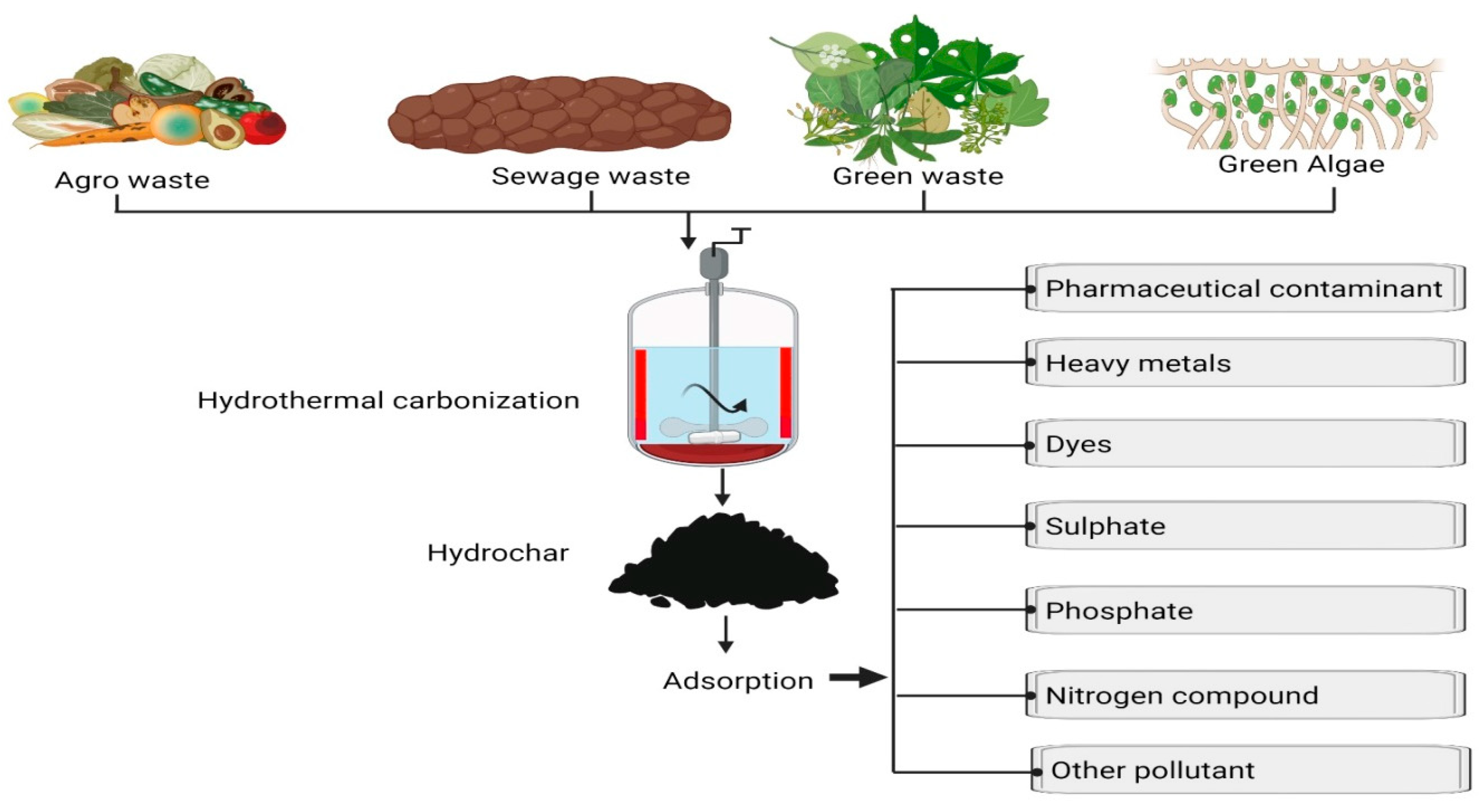
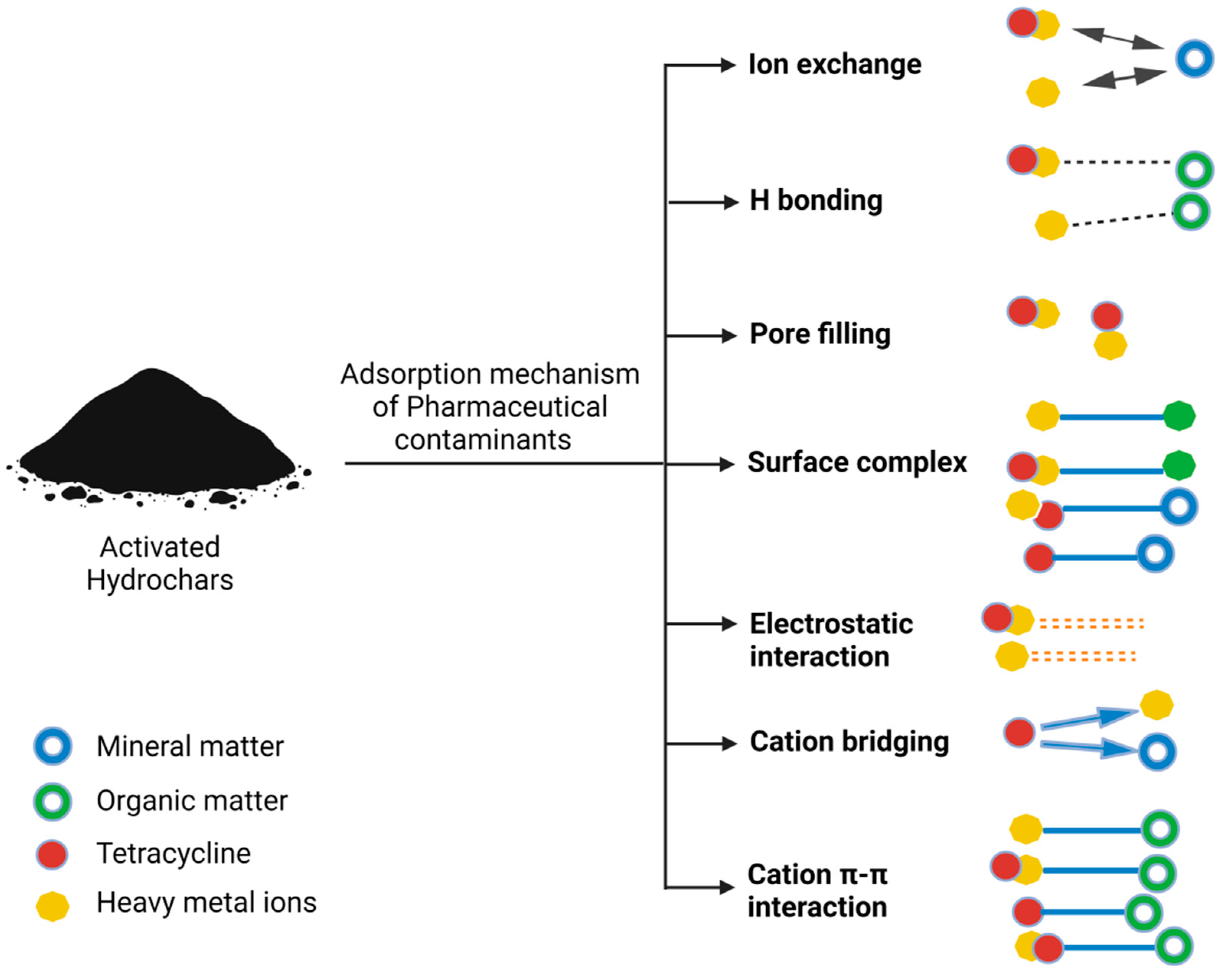
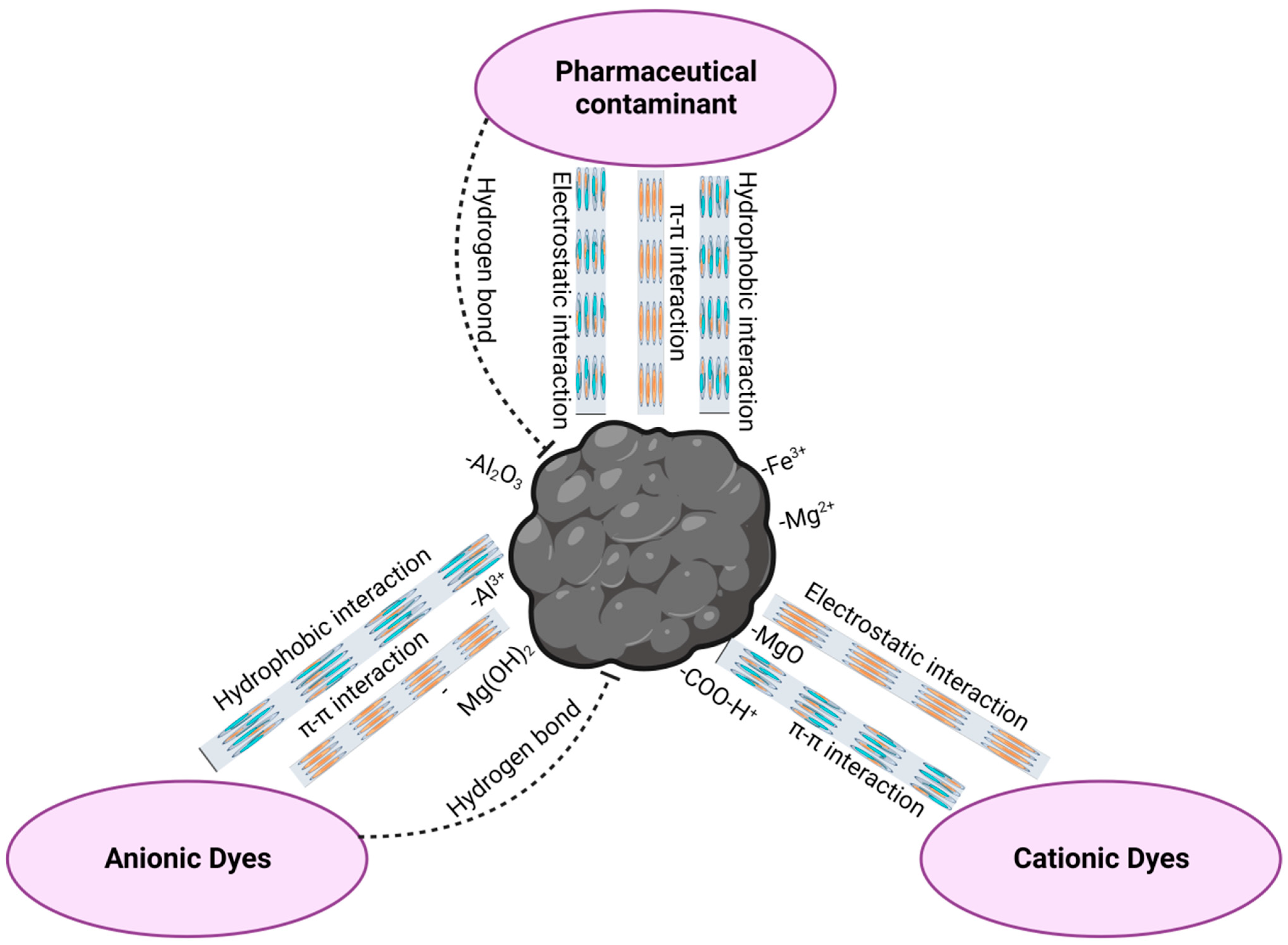
| Characteristic | Activated Hydrochar | Activated Carbon | Clay Minerals | References |
|---|---|---|---|---|
| Selectivity for Pharmaceuticals | Customizable with functionalization | Pharmaceutical selectivity varies | Pharmaceutical selectivity varies | [23] |
| Sustainability | Eco-friendly, often from organic waste | Source-dependent, non-renewables | Plentiful, naturally sourced, eco-friendly | [45,46] |
| Adsorption Capacity | High adsorption | Strong adsorption capacity | Very high | [45] |
| Tunable Properties | Adjustable via activation methods | Limited tunability; depends on source and process | Limited tunability; properties linked to clay type | [45] |
| High Surface Area | High surface area typically observed | High surface area | Less surface area than hydrochar and activated carbon | [23] |
| Porous Structure | Porous structure for better adsorption efficiency | Porous structure for efficient adsorption | Porous structure, especially in smectite-type clays | [46,47] |
| Carbon Sequestration | Carbon sequestration via hydrothermal carbonization | Not applicable | Not applicable | [46] |
| Feedstock Diversity | From diverse organic waste | Coal, coconut, wood feedstocks | Various clay mineral types | [47] |
| Proven Performance | Efficient for targeted adsorption | Versatile and extensively applied | Removes specific heavy metals | [47] |
| Cost | Economical from waste materials | Cost varies with source | Cost-effective due to abundance | [45,46,47] |
| Regeneration | Reusability is common | Regenerable for reuse | Frequently regenerable for reuse | [45,46,47] |
| Application Specificity | Adaptable and targeted adsorption | Highly versatile and effective | Potent against heavy metals | [45,46,47] |
| Customizability | Customizable with varied activation | Customizability limitations | Customizability limitations | [23,45,46,47] |
| Environmental Impact | Environmentally friendly | High energy usage | High energy usage | [45,46,47] |
| Hydrochar | BET Surface Area Characteristics | Pharmaceutical Contaminant | Probable Interaction between Adsorbent and Pharmaceutical Contaminant | References |
|---|---|---|---|---|
| Dried leaf hydrochar derived activated carbon | BET surface area of 647.88 m2/g, well-developed pore, t-Plot micropore volume of 0.0676 cm3/g | 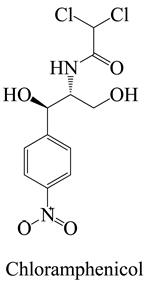 | Chloramphenicol (CP) exhibits potent electron-accepting properties due to ketone, nitro, and benzene groups. Adsorption on hydrochar surfaces involves polarized π-electron interactions through electro-donor acceptor (EDA) mechanisms, fostering hydrogen bonding between N-H, –OH groups in CP and O-containing groups (COOH, -CO, etc.) on the hydrochar surface. | [80] |
| Magnetic activated sawdust hydrochar | BET surface area of 1710.3 m2/g, pore volume of 0.969 cm3/g, average pore size of 2.26 nm |  | The activated carbon features varied pore quantities, and notable adsorption interactions, particularly π–π electron donor–acceptor interaction with the graphitic layer, contribute to its efficacy in adsorbing TC. In hydrochars, the higher surface areas, coupled with π–π electron donor–acceptor interaction and hydrogen bonding, are potential mechanisms driving effective adsorption. | [81] |
| Phosphate-modified hydrochar | --- |  | Phosphate-modified hydrochar demonstrates effective adsorption of ciprofloxacin antibiotic through mechanisms involving hydrogen bonding, pore filling, and electrostatic attraction. | [82] |
| Polyethyleneimine nitrogen-doped hydrochars (PEI) | BET surface area of 0.45 to 0.02 m2/g with a standard deviation of 0.18, exhibit no porosity | 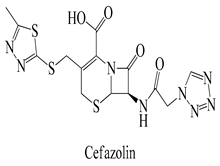 | The exceptional adsorption capacity of polyethyleneimine nitrogen-doped hydrochars is attributed to their high positive surface charge, exemplified by a high point of zero charge (PZC) at 9.7. Approximately 50% of the protonated amino groups in polyethyleneimine (PEI) at the operational pH, distributed along the chain, contribute to a substantial charge density. This high charge density facilitates robust electrostatic attractions between the positively charged active sites and the negatively charged carboxyl groups of the ciprofloxacin antibiotic (CFZ), thereby enhancing their adsorption. | [83] |
| Polyethyleneimine nitrogen-doped hydrochars (PEI) | BET surface area of 0.45 to 0.02 m2/g with a standard deviation of 0.18, exhibit no porosity | 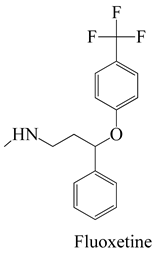 | Fluoxetine (FLX) adsorption on polyethyleneimine nitrogen-doped hydrochars (PEI) is likely facilitated by hydrogen bonding between the CF3 group (FLX) and the positively charged –NH groups of PEI, resembling a mechanism observed in pharmaceutical adsorption within the body. | [83] |
| Calcined spherical hydrochar (CSH) | BET surface area of 257.3 m2/g, average pore diameter of 2.27 nm, total pore volume of 0.17 cm3/g |  | Electrostatic interactions, influenced by the pKa value of ibuprofen (IPF) (4.91) and the pHiep of the CSH (3.21), are a plausible adsorption mechanism. Additionally, the pore-filling mechanism and hydrophobic interactions may contribute to the overall adsorption of IPF onto CSH. | [67] |
| Calcium alginate/activated hydrochar (CAAH) | AL-AHC: BET surface area of 533.42 m2/g, average pore diameter of 2.121 nm, a total pore volume of 0.283 cm3/g, micropore volume of 0.196 cm3/g | 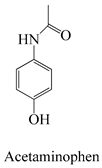 | The expansion of the pore network facilitates acetaminophen adsorption through the pore-filling mechanism of CAAH. | [84] |
| Palm-kernel-shell-derived hydrochar (PKC) | Surface area of 131 m2/g, diameter of pores between 2 and 50 nm | 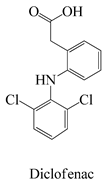 | Diclofenac (DCF) engages in strong hydrogen bonding via its diarylamine and carboxylic acid groups, and non-polar interactions through van der Waals bonding between non-polar groups. Aromatic rings contribute to π–π interactions through aromatic stacking. The presence of phenolic groups in PKC enhances bonding with DCF, particularly through aromatic π–π stacking and hydrogen bonding between -OH groups of phenol and carboxylic acid groups of DCF, likely accounting for effective removal at acidic pH. | [26] |
| Acid-modified hydrochar | ---- |  | Hydrogen bonds (H-bonds) and π–π electron donor–acceptor (EDA) interactions constitute the primary mechanisms of interaction between acid-modified hydrochar and sulfachlorpyridazine. | [70] |
| Hydrochar/Biochar Types | Hydrochar Preparation Process | Mechanism | Sorption Capacity (mg/g) | Pharmaceutical Compound Removed | Kinetics | Reference |
|---|---|---|---|---|---|---|
| Salix psammophila | The surface area of the resulting hydrochars exhibits a growth pattern as the HTC temperature escalates up to 250 °C | Activated hydrochar produced porous carbon with improved surface area | 27.00 | Tetracycline | – | [91] |
| Palm oil kernel shell waste | Hydrothermal carbonization and activation at 200–400 °C | Surface functional groups played a major role in the adsorption | 131.00 | Diclofenac sodium | Pseudo-second-order kinetic | [26] |
| Olive oil waste | Olive residue heated, hydrothermal carbonization, yields hydrochar, a sustainable, biochar-like material. Requires temperature range of 180 °C to 250 °C | Hydrogen bonds, multiple salt linkages, and van der Waals forces. Formation of bidentate complexes between iron hydroxides and arsenic anion | - | Triclosan | – | [92] |
| Olive oil waste | Olive residue heated, hydrothermal carbonization, yields hydrochar, a sustainable, biochar-like material. Requires temperature range of 180 °C to 250 °C | Phenolic compounds on the surface of hydrochar played important role of sorption. Higher surface area | - | Ibuprofen | – | [92] |
| Olive oil waste | Olive residue heated, hydrothermal carbonization, yields hydrochar, a sustainable, biochar-like material. Requires temperature range of 180 °C to 250 °C | Hydrogen bonds, multiple salt linkages, and phenolic compounds | - | Diclofenac | – | [92] |
| Cotton gin waste | Biochar pyrolysis temperature from 350 °C to 700 °C led to an increase in pH, specific surface area, and surface hydrophobicity | Hydrophobic partitioning, hydrogen bonding, and π–π electron donor–acceptor interactions | 1.50 | Sulfapyridine, Docusate, and Erythromycin | Pseudo-second-order kinetic | [93] |
| Banana pseudostem hydrochar | CoFe2O4 impregnation at 350–650 °C for 2 h at 10 °C/min | Hydrogen bonds, multiple salt linkages, and van der Waals forces | 99.76 | Amoxicillin | Pseudo second order | [94] |
| Oil palm fiber | ZnCl2 impregnation at 550 °C for 30 min at 5 °C/min | Formation of bidentate complexes | 7.30 | Acetaminophen | Pseudo second order | [95] |
| Wood chips | Ball milling at 800 °C for 7 h | Hydrogen bonding and π–π electron donor–acceptor interactions | 196.00 | Acetaminophen | Pseudo second order | [96] |
| Pomelo peels | 700 °C for 3 h | Formation of bidentate complexes | 147.00 | Acetaminophen | Elovich model | [97] |
| Pure glucose | Pre-pyrolysis and hydrothermal treatment at 900 °C for 3 h | Hydrogen bonds, multiple salt linkages, and van der Waals forces | 286.00 | Acetaminophen | Elovich model | [97] |
| Oil palm fiber | ZnCl2 impregnation at 550 °C for 30 min at 5 °C/min | Hydrogen bonding and π–π electron donor–acceptor interactions | 7.90 | Cephalexin | Pseudo second order | [95] |
| Used tea leaves | 450 °C at 30 min | Hydrogen bonding and π–π electron donor–acceptor interactions | 238.10 | Ciprofloxacin | Pseudo second order | [98] |
| Corncobs | 600 °C for 2 h | Hydrogen bonds, multiple salt linkages, and van der Waals forces | 0.40 | Ciprofloxacin | Pseudo second order | [99] |
| Pine needle hydrochar | Oxidized with boiling nitric acid at 650 °C | Hydrogen bonding and π–π electron donor–acceptor interactions | 6.54 | Caffeine | Pseudo second order | [100] |
| Bovine bone | AlCl3 and MgCl2 loading at 650 °C | Hydrogen bonds, multiple salt linkages, and van der Waals forces | 26.21 | Caffeine | Pseudo second order | [101] |
| Rice hull | Torrefied at 350 °C for 1 h | Hydrogen bonding and π–π electron donor–acceptor interactions | 3.3 | Sodium diclofenac | Pseudo second order | [102] |
| Moringa seed powder | Chemical activation with H3PO4 at 450 °C for 2 h at 10 °C/min | Hydrogen bonds, multiple salt linkages | 100.87 | Sodium diclofenac | Pseudo second order | [103] |
| Sludge of textile effluent treatment plant rich in iron chloride | 400 °C for 4 h at 10 °C/min | Hydrogen bonds, multiple salt linkages, and van der Waals forces | 19.7 | Ofloxacin | Intra-particle diffusion model | [104] |
| Walnut shell | Microwave treatment of walnut shell and FeCl3 at 600 °C for 2 h | Formation of bidentate complexes | 444 | Ketoprofen | Pseudo second order | [105] |
| Corn husks | Pyrolysis FeCl3 impregnation at 300 °C for 1 h at 5 °C/min | Formation of bidentate complexes | 273.7 | Levofloxacin | Intra-particle diffusion model | [106] |
| Coconut shell | Chemical activation with H3PO4 at 400 °C for 1 h | Hydrogen bonding and π–π electron donor–acceptor interactions | 12.16 | Ibuprofen | Pseudo first order | [107] |
| Date stone seeds | Chemical activation with H3PO4 at 700 °C for 1 h | Hydrogen bonds, multiple salt linkages, and van der Waals forces | 12.16 | Ibuprofen | Pseudo second order | [108] |
| Wood apple fruit shell | Steam activation at 650 °C for 1 h | Hydrogen bonds, multiple salt linkages | 12.65 | Ibuprofen | Pseudo second order | [109] |
| Wood chips | 800 °C for 7 h | Hydrogen bonding and π–π electron donor–acceptor interactions | 132 | Ibuprofen | Pseudo second order | [96] |
| Mung bean husk | Steam activation at 650 °C | Hydrogen bonding and π–π electron donor–acceptor interactions | 59.76 | Ibuprofen | Pseudo second order | [110] |
| Walnut shell | Microwave treatment of walnut shell and FeCl3 at 600 °C for 2 h | Hydrogen bonds, multiple salt linkages | 533 | Naproxen | Pseudo second order | [105] |
| Rice straw | Chemical activation with H3PO4 at 700 °C for 2 h | van der Waals forces | 552 | Tetracycline | Pseudo second order | [111] |
| Swine manure | Chemical activation with H3PO4 at 700 °C for 2 h | Hydrogen bonding and π–π electron donor–acceptor interactions | 365.40 | Tetracycline | Pseudo second order | [111] |
| Food and garden waste | 300 °C for 12 h | Hydrogen bonds, multiple salt linkages, and van der Waals forces | 9.45 | Tetracycline | Elovich model | [112] |
| Rice straw | 700 °C for 2 h at 26 °C/min | Formation of bidentate complexes | 14.16 | Tetracycline | – | [113] |
| Walnut shell | Microwave treatment of walnut shell and FeCl3 at 600 °C for 2 h | Hydrogen bonds, multiple salt linkages, and van der Waals forces | 683 | Salicylic acid | Pseudo second order | [105] |
| Eucalyptus globulus wood | Chemical activation with H3PO4 at 400 °C for 2 h | Hydrogen bonds, multiple salt linkages, and van der Waals forces | 28.29 | Sulfamethoxazole | – | [114] |
| Raw bamboo | Ball milling at 450 °C for 2 h | Hydrogen bonding and π–π electron donor–acceptor interactions | 25.7 | Sulfamethoxazole | Elovich model | [115] |
| Tea waste | Steam activation at 700 °C for 2 h | van der Waals forces | 33.81 | Sulfamethazine | – | [116] |
| Eucalyptus globulus wood | Chemical activation with H3PO4 at 400 °C for 2 h | Hydrogen bonds, multiple salt linkages, and van der Waals forces | 20.71 | Sulfamethazine | – | [114] |
| Hickory chips | 450 °C for 2 h | Formation of bidentate complexes | 58.6 | Sulfapyridine | Elovich model | [115] |
Disclaimer/Publisher’s Note: The statements, opinions and data contained in all publications are solely those of the individual author(s) and contributor(s) and not of MDPI and/or the editor(s). MDPI and/or the editor(s) disclaim responsibility for any injury to people or property resulting from any ideas, methods, instructions or products referred to in the content. |
© 2024 by the authors. Licensee MDPI, Basel, Switzerland. This article is an open access article distributed under the terms and conditions of the Creative Commons Attribution (CC BY) license (https://creativecommons.org/licenses/by/4.0/).
Share and Cite
Gautam, M.K.; Mondal, T.; Nath, R.; Mahajon, B.; Chincholikar, M.; Bose, A.; Das, D.; Das, R.; Mondal, S. Harnessing Activated Hydrochars: A Novel Approach for Pharmaceutical Contaminant Removal. C 2024, 10, 8. https://doi.org/10.3390/c10010008
Gautam MK, Mondal T, Nath R, Mahajon B, Chincholikar M, Bose A, Das D, Das R, Mondal S. Harnessing Activated Hydrochars: A Novel Approach for Pharmaceutical Contaminant Removal. C. 2024; 10(1):8. https://doi.org/10.3390/c10010008
Chicago/Turabian StyleGautam, Manish Kumar, Tamal Mondal, Rupashri Nath, Bidhan Mahajon, Mukesh Chincholikar, Anirbandeep Bose, Dibya Das, Rakesh Das, and Sandip Mondal. 2024. "Harnessing Activated Hydrochars: A Novel Approach for Pharmaceutical Contaminant Removal" C 10, no. 1: 8. https://doi.org/10.3390/c10010008
APA StyleGautam, M. K., Mondal, T., Nath, R., Mahajon, B., Chincholikar, M., Bose, A., Das, D., Das, R., & Mondal, S. (2024). Harnessing Activated Hydrochars: A Novel Approach for Pharmaceutical Contaminant Removal. C, 10(1), 8. https://doi.org/10.3390/c10010008






